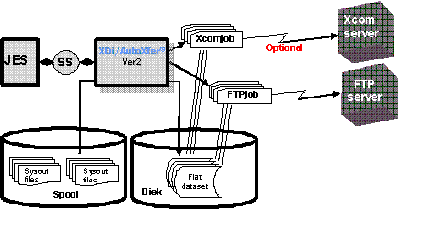
XDI/AutoXfer©
XDI/AutoXfer© – Automatic Spool/Outputs Distribution
The spool output files of each application is generally only for direct printing in the computer room. Of course, that’s not all printed. Instead, only certain reports that are needed to be printed are selected. Because the same information can actually be seen online.
However, in reality many institutions require almost all of these reports, especially banks. The reason is commonly about juridical and legality of information. In fact, sometimes reports have to be reprinted for certain reasons. So the huge number of spool files must be maintained for a long time. Of course this is a very expensive task, maintaining them on the mainframe.
XDI/AutoXfer© is a solution to avoid the expense of maintaining the spool output on the mainframe. XDI/AutoXfer will automatically capture every spool output file that is being generated by a batch job and as soon as it is closed, send it to a number of computers targeted as recipients. This is performed based on a table that lists what reports will be sent to which computers.
Thus, the existence of the report files is no longer on the mainframe, but on the receiving computer which is generally a PC. It will be much cheaper and simpler. And most importantly, the responsibility for maintaining the report is no longer on the mainframe team, but exclusively on each user of the report.
Technically, the delivery is done using FTP, either as a separate batch job, or directly through an API intermediary, on user’s choice. In FTP session, XDI/AutoXfer acts as a client. So that the receiving computer does not need any agent from zJOS-XDI, but just an FTP server. Again, very simple and cheap.

Benefits
- Efficiency of spool backup device (disk/cartridge)
- Simple and flexible to manage report
- “Unattended” operation
- Simple and easy to implement
- User can ask for specific modification
- Messages are complete and representative
- Distribute reports as user required
- Users don’t need to logon mainframe
- Data Centre has no more responsibility regarding user’s reports
- No need special skill for users and DC personnel
Features
When you don’t like target file naming (on target computer) given by CA-XcomTM
You can schedule command or task based on clock time indicator daily
Also can schedule command or task in every certain time period
- File Transfer
- Spool/Report Transfer
- Automated Spool Transfer
- Automated Spool Distribution
- Job Transfer
- Plug and Play with CA-DispatchTM
- Plug and Play with Control-DTM
- Can be used to manage CA-XcomTM
- Time based console automation
Concept
- 2-level hierarchy of target organization
Represents target specifications
Contains one or more recipients
- Destination
IP address or name
Same spec among recipients in one destination
- Recipient
- 2-form of text on target computer
- MVS – original JES spool output format
- Windows – notepad format
- XDI function is DISTRIBUTION instead of just transfer or download
- Distribution function is represented at destination level
- Each recipient within a destination will receive exactly the same amount of files with the same specifications
How XDi/AutoXfer Work
- Event base
- Multitasking
- Log in DIV
- Works with standard FTP
- Optionally work with CA-XcomTM
- Trap each generated report file on JES spool in designated 1-to-8 classes
- Translate its destination tag to recipient’s IP address(es) according to XDI destination tables
- Transfer it to recipient’s IP address(es)
- Delete its original. Optionally can leave it.



